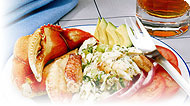Gluten-Free Diet

Best Bets
- Amaranth
- Arrowroot
- Bean or pea flours
- Buckwheat*
- Corn
- Flaxseed
- Fruit, not dried or in commercial pie fillings
- Meat, poultry, fish not processed with gluten-containing addititives, not breaded, and without gravies or sauces
- Milk products, not malted or flavored
- Millet
- Montina
- Nut and seed flours
- Potato flour, potato starch
- Quinoa
- Rice and rice bran
- Sago
- Sorghum
- Soy flour
- Tapioca
- Teff
- Vegetables, not creamed or breaded
- Wild rice
While wheat is one of the major gluten-containing grains, it is important to remember that “wheat-free” does not mean “gluten-free.” Make sure to carefully read food labels to determine if an item features gluten-containing items.
Prepare a note card with the foods that you need to avoid and bring this with you when food shopping or dining in restaurants. Communicate your special needs to the waiter or manager so that they can guide you to dishes that do not contain gluten.
Gluten allergies can often start in childhood as a result of early feeding of grains; consider breast-feeding your child for the first six months.
Be careful when buying grains from bulk bins. Make sure that the grains are adequately separated from the gluten-containing grains in order to avoid cross-contamination.
Foods to Avoid
To avoid gluten, ask about ingredients at restaurants and others’ homes, and read food labels. Avoid questionable products until the manufacturer guarantees they are gluten-free. Recheck products regularly as ingredients may change.
Beginning in 2006, food labels in the US must accurately declare in a special “allergy statement” if wheat protein, even in small amounts, is present in an ingredient used in that food. However, this regulation does not pertain to other gluten-containing grains, so labels must still be checked carefully for those sources.
At home, care should be taken to keep gluten-containing foods used by other members of the household from contaminating cooking appliances, food-preparation surfaces, utensils, shared condiment jars, and so forth.
The following list is not complete. Consult with a healthcare professional before making any significant changes to your diet. Grains and grain products to avoid (check ingredients of breads, breading, cereals, coating mixes, crackers, croutons, fried snacks, muffins, pasta, pastries, stuffing, and so on):
- Barley
- Bulgar
- Couscous
- Dinkle
- Einkorn
- Emmer
- Farina
- Faro
- Flour: any made from grains on this list; bread, brown, durum, granary, strong, and whole-meal flour usually indicate flours containing gluten
- KAMUT wheat
- Malt
- Matzo
- Oats and oat bran*
- Orzo
- Panko
- Rye
- Seitan
- Semolina
- Spelt
- Triticale
- Udon
- Wheat
- Wheat bran
- Wheat germ
*While oats contain a substance similar to gluten, modern research has found that eating moderate amounts of oats does not appear to cause problems for people with celiac disease or dermatitis herpetiformis. However, oats may be contaminated with gluten from other grains during processing; therefore using only oat products that have been tested and guaranteed to be free of gluten is recommended.
Other food products and ingredients that may contain gluten (check labels or manufacturer for ingredients from the list above):
- Ale, beer, stout, lager
- Broth
- Brown rice syrup
- Candy
- Cloudy lemonade
- Curry mixes
- Dried meals
- Egg substitutes
- Flavored instant coffee
- Ginger beer
- Grain spirits
- Gravy cubes and mixes
- Hot chocolate mixes
- Hydrolyzed vegetable protein (also called hydrolyzed plant protein or protein hydrolysate) if made from wheat
- Ice cream
- Imitation bacon and seafood
- Licorice
- Malt vinegar (distilled vinegars are gluten-free)
- Marinades
- Mustard powder
- Nondairy cream substitutes
- Nuts, dry roasted
- Prepared meats (bologna, lunch ham, and so on)
- Rice paper
- Root beer
- Roux
- Sauces and sauce mixes
- Self-basting poultry
- Soup and soup mixes
- Soy sauce and shoyu tamari
- Starch, when labeled as wheat starch, modified food starch, or vegetable starch
- Stock cubes
- Suet in packets
- Thickeners
Be careful of the following personal and over-the-counter items, which may contain small amounts of gluten:
- Communion wafers
- Glue (US-made envelope glue is reportedly gluten-free)
- Lipstick, gloss, and balms
- Prescription and over-the-counter medications listing gluten, starch, flour, or dusting powder as excipients
- Supplements listing gluten, starch, flour, or dusting powder as excipients
Copyright © 2025 TraceGains, Inc. All rights reserved.
Learn more about TraceGains, the company.
The information presented by TraceGains is for informational purposes only. It is based on scientific studies (human, animal, or in vitro), clinical experience, or traditional usage as cited in each article. The results reported may not necessarily occur in all individuals. Self-treatment is not recommended for life-threatening conditions that require medical treatment under a doctor's care. For many of the conditions discussed, treatment with prescription or over the counter medication is also available. Consult your doctor, practitioner, and/or pharmacist for any health problem and before using any supplements or before making any changes in prescribed medications. Information expires December 2025.
